Detailed documentation about all features and settings of Booking Calendar Contact Form.
From the dashboard/configuration area the process is as follows:
From the end user (visitor) point of view, the process is as follows:
If the calendar is enabled it will appear in the top of the form and the user will be asked to select the start and end dates of the booking by clicking over the related dates in the calendar.
Once the dates have been selected the booking price will be shown below the calendar.
The rest of the form will appear below the calendar (or directly if the calendar isn't enabled) and the submit/continue button at the bottom of the form.
After clicking "submit / continue" there are three possible scenarios:
In all cases, after returning from PayPal or after clicking the submit button if PayPal isn't enabled, the user will be redirected to the page specified into the settings field "URL to return after successful payment".
To install the WordPress plugin follow these steps:


After going to the WordPress administration menu >> Settings >> Booking Calendar Contact Form you will see the list of forms/calendars like in the following image:
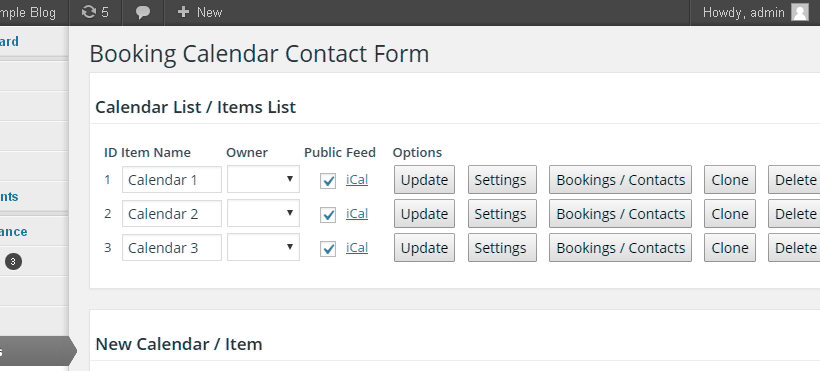
For each form you will see the following options:
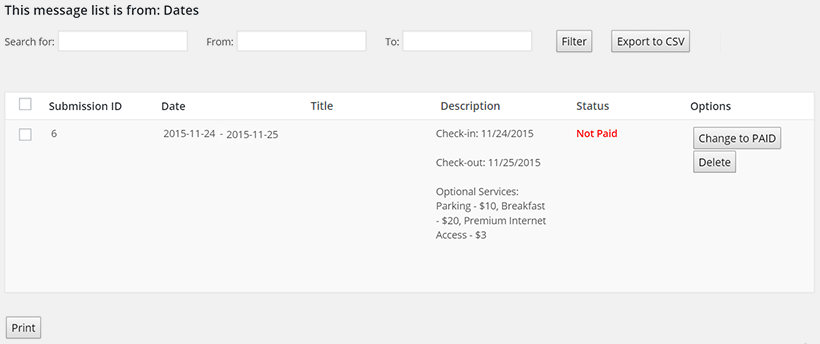
Press the "Bookings / Contacts" button, corresponding to the calendar/form. The messages screen displays the list of submissions, and a filtering section to reduce the submissions by form, a time interval, or a text in the data
From the messages screen it is possible remove a submission, or submissions group, change its status to paid/unpaid and also export all submissions to a CSV file

For exporting the submitted information to a CSV file, press the "Bookings / Contacts" button corresponding to the calendar/form, and press the "Export to CSV" button, select the location where will be saved the CSV and that's all. The first row of CSV file allows identify each of fields, the text used to identify the field will be the short label, defined in the field, or the label in case that the short label is not defined.
The calendar in the settings area appears only if it is enabled and if the option "Accept overlapped reservations" is set to "No" (it's the default value).
To block a date interval click the start and end dates into the calendar, a floating panel will appear for entering some text (ex: specify why it's blocked), just enter some text and click "save", this action will block the dates.
To edit/delete blocked dates use the edit and delete buttons that appear on the popup when moving the mouse over marked dates.
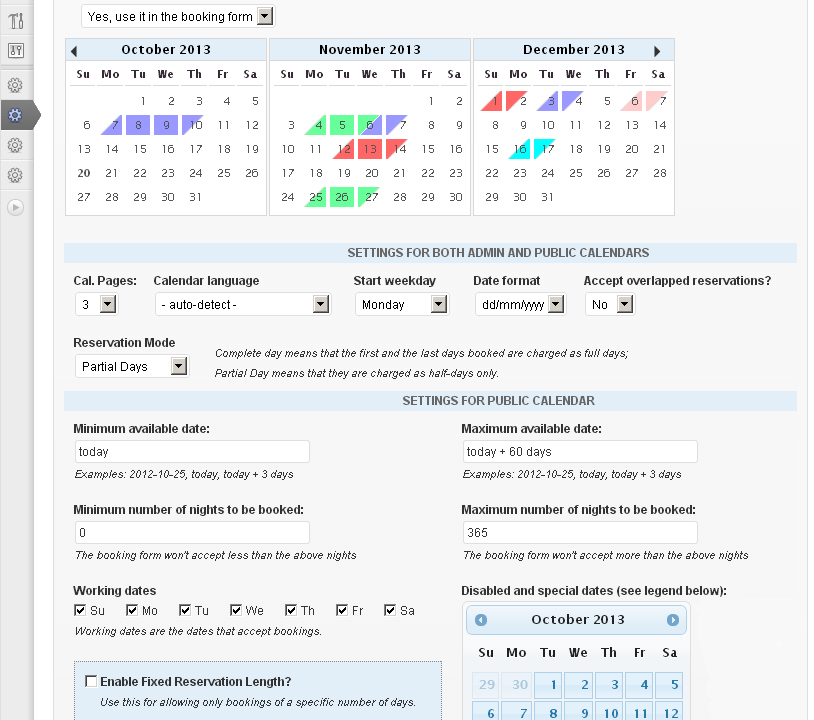
Below the calendar there are several configuration settings that are explained in the section below.
The Form Builder lets you to add/edit/remove fields into the form and also to specify the validation rules for your form (required fields, email fields, etc...).

The "Form Settings" tab allows define the form's title and description, as the placement of labels respect the fields (at top, at left, aligned to the right). In the "Form Settings" tab is possible to decide the form's design. The plugin includes multiple predefined designs.
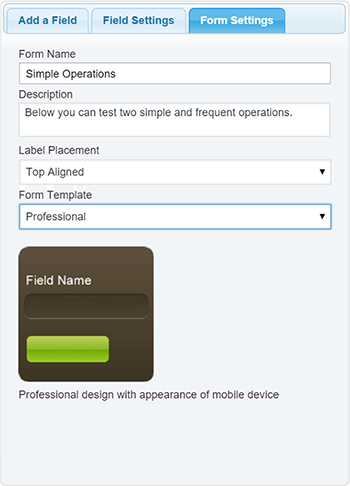
* Note: Some of the field types are available only in the commercial versions of the plugin.
The form builder includes some container controls. The container controls allow to insert another controls in them:
In addition to the above, the following fields are available only in the commercial versions of plugin:
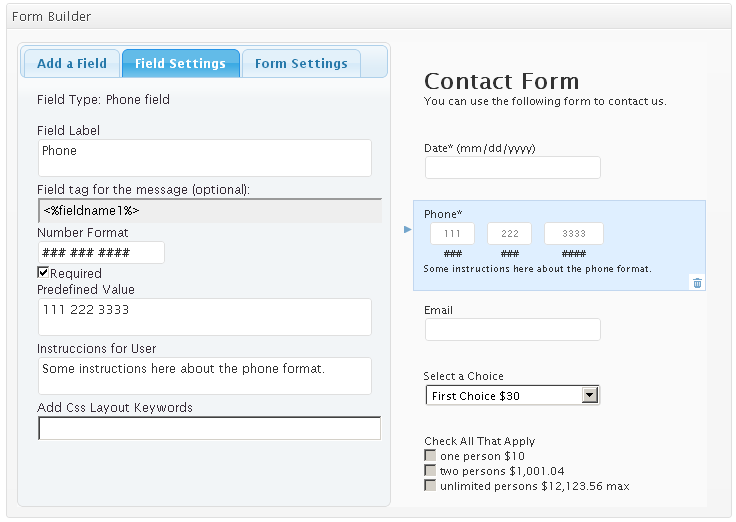
When you click a field already added, you can edit its details and validation rules. The following properties are useful:
This is a step by step about the use of datasource controls
There are different datasources: Database, CSV file, Post Type, Taxonomy, and User Data.
Note: Depending of control selected will be available all available datasources, or not.
So, suppose we want populate the field with the data stored in a database table.
Note: If the database is the same used by WordPress, leave empty the fields above.
Now its time to define the query to database
If your query is very complex, and you prefer create it manually; selects the option "Custom Query", but in this case you should type all the query. Pay attention because you should use alias in the "SELECT" clause, to indicate the colum used to get the values, and the column used to get the texts. For example, a hypothetical query:
SELECT column1 AS value, column2 AS text FROM tablename WHERE column3 > 5 ORDER BY column2 ASC LIMIT 5
The use of database as datasource, allows filtering the information to populate the fields with the values on other fields in the form, or javascript variable. The use of variables are only accepted in the "Condition" section ("WHERE" clause), and requires the format: <%varname%>. For example, to get the title of a post, filtering by its ID, if the id is defined through the fieldname3 field, the "Condition" attribute of the query would be: ID=<%fieldname3%>
The CSV files can be used as data sources for fields with multiple choices (DropDown DS, Radio Btns DS, Checkboxes DS). The initial steps are similar to the previous section, but selecting the "CSV" option as data-source instead of selecting "Database".
A comma-separated values (CSV) file stores tabular data (numbers and text) in plain text. Each line of the file is a data record. Each record consists of one or more fields, separated by commas. The use of the comma as a field separator is the source of the name for this file format.
For CSV files, the plugin includes the attributes:
Select CSV file: file field to select the CSV file.
Use headline: tick the checkbox if the first line of CSV file is a headline to identify the data in the next records.
Delimiter: enter the delimiter symbol used as the field separator on each record.
Press the "Import CSV" button to import the records into the form. This action will feed the lists "Select column for texts" and "Select column for values", that are used for selecting which fields will be used texts and values of the choices in the DS field.
Some fields, like radio groups, checkboxes and drop-down menu, allow dependencies in function to the option selected.
For example, suppose your form includes a radio-group control with multiple choices: - House, - Car, - Electrodomestics, and each of them, uses different attributes. The house requires fields for address, number of rooms, etc; the car requires a field for trademark, model, etc. and finally the electrodomestics, will need type of electrodomestic,and more. So, if you want display the fields, depending of choice selected:
For each calendar/form you will be able to edit the following settings:
Already explained in sections above.
If enabled, use the services/items field as: Define here how you want to use this field. There are 4 possibilities:
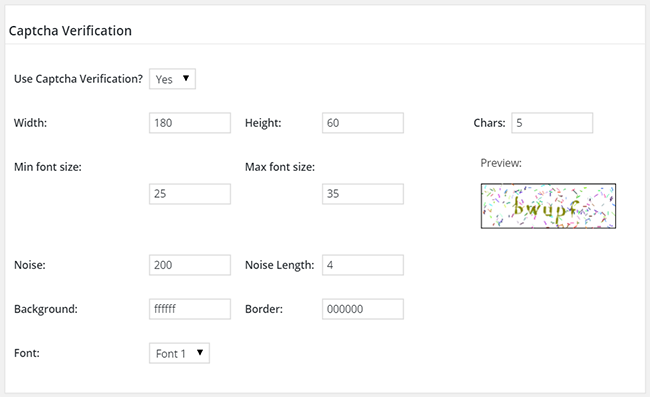
The list of add-ons available in the plugin, appear in the "Add-ons area" of settings page of the plugin. For enabling the add-ons, simply should tick the corresponding checkboxes, and press the "Activate/Deactivate Addons" button.

The commercial versions of the plugin includes the WooCommerce add-on, to integrate the forms created by the "Booking Calendar Contact Form" with the WooCommerce products. The add-on inserts an additional metabox in the WooCommerce products, with two settings fields:
Note: If you want calculate the price of products through the form, will be required that you select the field of the price in the attribute: "Request cost" in the form's settings.

The add-on allows create new leads in the SalesForce account with the data submitted by the forms.
To create new leads in SalesForce with the data submitted by a form, be sure that the SalesForce account has enabled the Web-to-lead option, and then go to the form's settings:
Note: The Add-on includes the list of predefined attributes of Leads, but it is possible to enter custom attributes too.

The add-on allows posting the submitted information by the forms to WebHooks URLs. With the WebHook add-on it is possible integrate the forms created by the plugin with services like Zapier. The Zapier connects services as important and popular as Zoho CRM, Dropbox, Mailchimp, Evernote, Google Drive, Facebook, Twitter, and more than 300 services(Zapier apps)
Use this add-on is as simple as entering the WebHooks URLs, through the WebHook section in the forms settings. To associate a form with multiple WebHooks, simply press the "Add new url" button, to add a new input field.
Note: About Zapier service, select Webhook as the Trigger app, and "Catch Hook" as the trigger for this app.
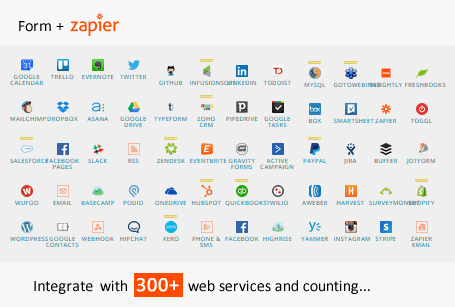
The add-on allows to protect the forms using the Google reCAPTCHA instead of the captcha distributed with the plugin. reCAPTCHA is more visual and intuitive than the traditional captcha, with just a single click the users confirm they are not a robot.
reCAPTCHA (its official name is No CAPTCHA reCAPTCHA) as they define themselves:
reCAPTCHA is a free service that protects your website from spam and abuse. reCAPTCHA uses an advanced risk analysis engine and adaptive CAPTCHAs to keep automated software from engaging in abusive activities on your site. It does this while letting your valid users pass through with ease.
reCAPTCHA offers more than just spam protection. Every time our CAPTCHAs are solved, that human effort helps digitize text, annotate images, and build machine learning datasets. This in turn helps preserve books, improve maps, and solve hard AI problems.
To use reCAPTCHA in your forms, activate the add-on in the the settings page of the plugin, through the menu option: "Settings/Booking Calendar Contact Form", tick the checkbox: "reCAPTCHA", and press the "Update" button.
The activation of reCAPTCHA displays a new section for entering the site key, and the secret key, two keys provided by Google reCAPTCHA to protect the website, and validate the forms submissions respectively.
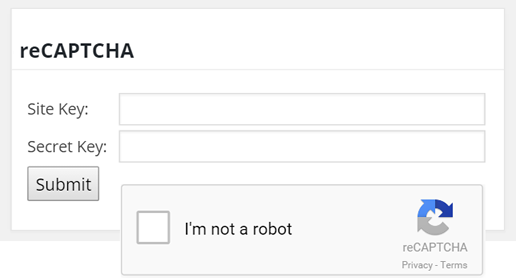
The Mollie addon provides integration with iDeal, the most popular Dutch payment method. The integration is made via Mollie: www.mollie.com.
You're easily connected to iDEAL through Mollie without the dreaded technical and administrative hassle. The iDEAL platform combines the online banking systems of 10 of the largest Dutch banks (ABN AMRO, ASN Bank, Bunq, ING, Knab, Rabobank, RegioBank, SNS Bank, Triodos Bank and van Lanschot) into one payment method.
After the consumer selects the iDEAL payment method the consumer's bank is selected. The actual payment then takes place in the bank's trusted online banking environment - for which security is guaranteed by the bank. Through iDEAL buyer and seller are guaranteed a transparent transaction without hidden fees or other unpleasant surprises.

In the settings area the following information is needed to activate and link the Mollie - iDeal account to the form:
When enabled, the customer will be redirected to the Mollie - iDeal payment form after the submision. The process will be similar to the way PayPal Standard works.
The RedSys / Servired / Sermepa addon provides a secure interface for accepting credit card payments through most banks in Spain (Sabadell, Banco Popular, BBVA, Santander, Bankia, Caixa, Bankinter, etc...). You can read more about RedSys at www.redsys.es.

In the settings area the following information is needed to activate and link the PayPal Pro account to the form:
When enabled, the customer will be redirected to the RedSys payment form after the submision. The process will be similar to the way PayPal Standard works.
With this addon the plugin supports PayPal Express in addition to the PayPal Standard integration. While it works in a similar way to PayPal Standard from the customer point of view (customer is redirected to a PayPal-hosted payment page without entering the credit card data into the WordPress website) it is technically more advanced, this means: it is more stable, more secure and doesn't relay in the IPN notifications for the post-payment actions.

In the settings area the following information is needed to activate and link the PayPal Express integration into the form:
To get the API keys into your PayPal account follow these steps:

The Stripe Payments addon provides a way to accept all major cards from customers around the world on web. This addon requires SSL on your website to be able to carry the transaction in a secure way. Credit card data is entered directly in the website without navigating to an external page.
Using Stripe you can accept credit card payment and also the following payment methods (can be enabled into the add-on): iDEAL, Bancontact, giropay, Przelewy24 and EPS. Includes SCA compliant (Strong Customer Authentication) integration.
You can activate the add-on in the add-ons area located below the list of booking forms.
In the settings area the following information is needed to activate and link the stripe account to the form:
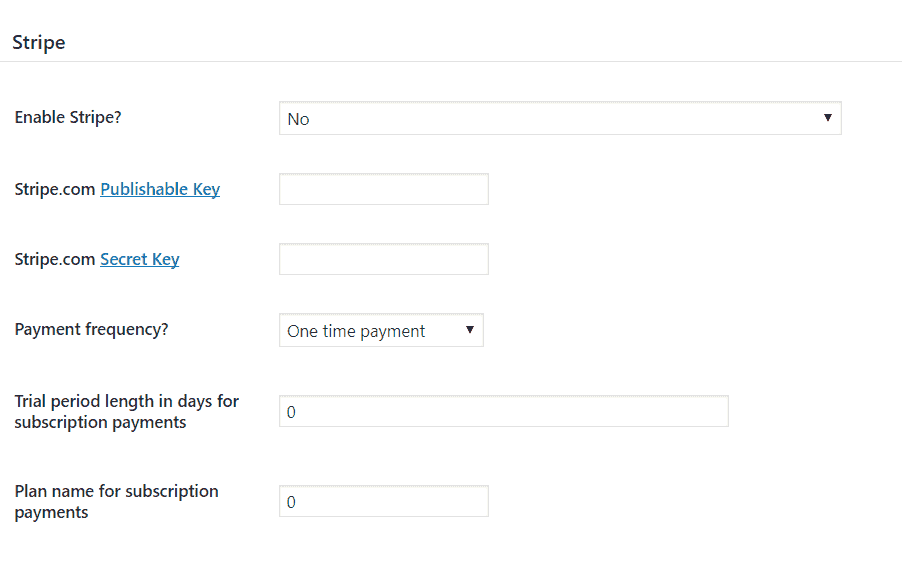
When enabled, after clicking the Booking Calendar Contact Form submit button, a Stripe floating panel (or a redirection to a Stripe hosted payment page, depending of the integration type selected) will be displayed to ask for the credit card data and process the transaction and after that the form submission will continue as usual.
The iCal Automatic Import addon provides a way to automatically import bookings from external calendars supporting iCal, like for example Google Calendar, Outlook Calendar, iCloud/Apple calendars, etc...
To activate the add-on, simply visit the plugin page through the menu option: "Settings/Booking Calendar Contact Form", tick the checkbox: "iCal Automatic Import", and press the "Activate/Deactivate addons" button.
In the settings area the following information is needed to activate and link the iCal calendar:
Enable iCal import for this calendars?: Select "Yes" to enable the iCal automatic import.
iCal URL: URL of the remove iCal file to be imported. Unless you know what you are doing it should start with http:// or https://
The iCal file will be automatically imported every one hour and each time the plugin settings are saved.
The CSV Import addon allows to import bookings from a CSV file.
To activate the add-on, simply visit the plugin page through the menu option: "Settings/Booking Calendar Contact Form", tick the checkbox: "CSV Import", and press the "Activate/Deactivate addons" button.
The import option will appear after the list of add-ons in the page that contains the list of calendars:

The format of the CSV file must be similar to the format of the CSV files exported form the "Bookings list". This means that the first line of the CSV file must contain the column names with the first column being "Calendar ID" and the next data rows must contain the Calendar ID in the first column.
To make the CSV file edition easier export first a CSV file from the "Bookings list" and then use that file as sample to create/edit the CSV file you want to import.
This feature can be used to export/backup the bookings and later re-import them. Note however that all the bookings in the CSV file are imported again, so keep that in mind to avoid duplicates in the database.

The "Troubleshoot Area & General Settings" section, allows correct some possible issues, or conflicts with third party plugins, and define the general settings.
For printing only the form, but not the rest of page, please, follows the steps below:
<SCRIPT>
function printForm(){
var w = window.open(null, 'Print_Page', 'scrollbars=yes');
jQuery('#fbuilder input').each(function () {
var e = jQuery(this);
e.text(e.val()).attr('value', e.val());
if (e.hasClass('large'))
e.css('width', '100%');
if (typeof e.prop('checked') != 'undefined')
e.attr('CHECKED', e.prop('checked'));
});
var html = jQuery('#fbuilder').html();
jQuery('#fbuilder TEXTAREA').each(function () {
var e = jQuery(this).parent().html();
html = html.replace(e, jQuery(this).val());
});
jQuery('#fbuilder SELECT').each(function () {
var e = jQuery(this).parent().html();
html = html.replace(e, jQuery(this).find('option:selected')[0].text);
});
w.document.write(html);
w.document.close();
w.print();
}
</SCRIPT>
printForm();